



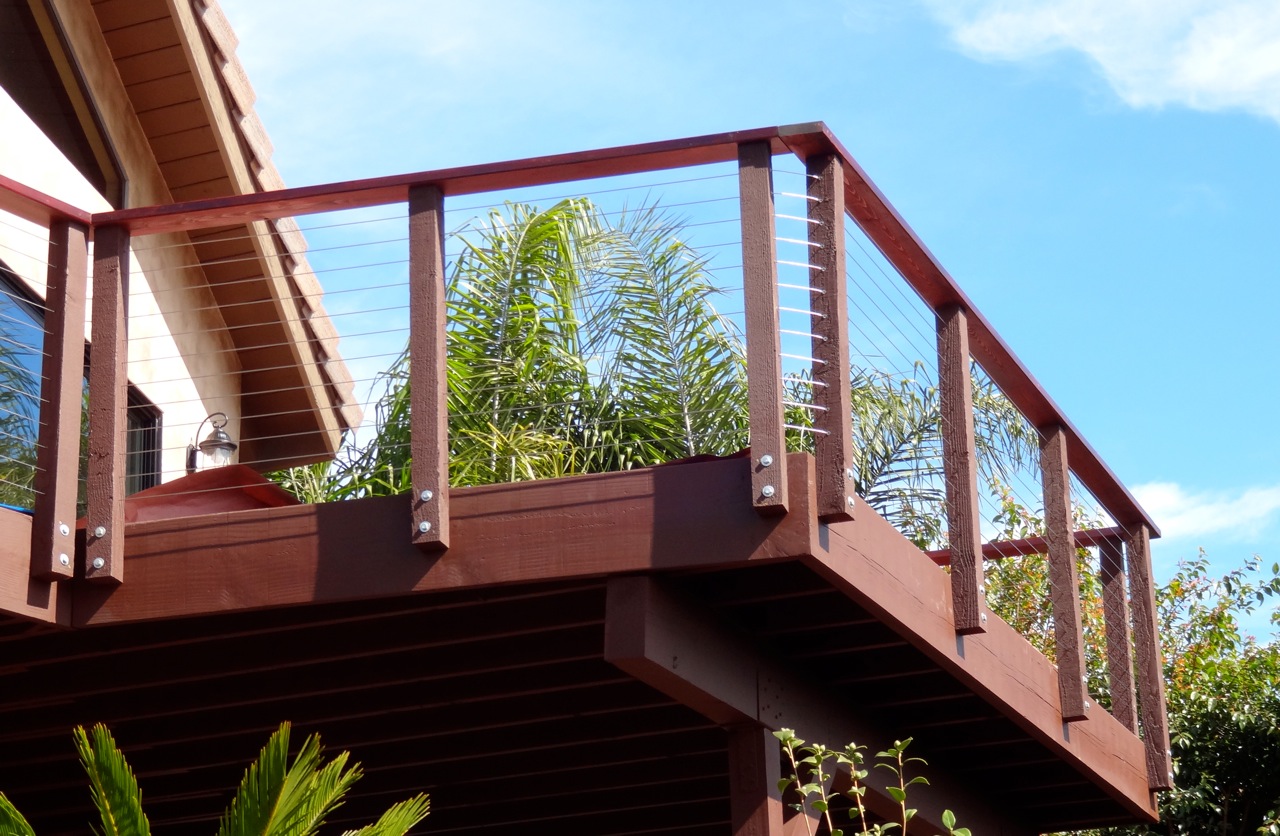
Pro Tips to Cut Your Hardware Cost and Save Money on Cable Railings If you’re looking to lower your cost on a deck railing this summer, check out the tips from our cable railing pros. Cable rail construction doesn’t have do be expensive nor do you need to sacrifice professional results to lower your cost. Anybody can save money on cable railings with a little pre-planning, proper layout and the right material choices: Use wooden posts and railing members- Wood timbers will almost always be less expensive than aluminum, steel and stainless steel. Exotic hardwoods can be an exception in certain cases however using cable railing frames made from Cedar, Fir or Redwood can cut the cost of your cable railing considerably. Pre-made wooden cable railing posts can be up to 50% less expensive than steel post alternatives. Maximize the useable spans of the hardware- Read up on the manufacturers recommendations for post spans and cable hardware. Extra fittings can greatly increase your cable cost so keep the hardware counts down whenever possible. Certain types of fittings like turnbuckles can increase your cable cost. Let the functionality of the project dictate the hardware application vs. focusing on the look of individual fittings. Use a wood top rail with steel posts- Even an exotic hardwood top rail will come at a lower premium than many steel top rail options. Additionally, the combination of steel posts and wood top rail can be made to conform to several different design styles. For example, a weathered wood top rail on steel posts can give rustic appeal with clean lines. Wooden top rails are versatile and readily available as well as DIY friendly. Consider a 2 post corner design- Using double posts at a 90 degree corner can cut your cable cost considerably. Cable cost is primarily in the fittings so running your cable the maximum recommended distance is a must. Turning the corner allows you to maximize the distance of the cable run and minimize the amount of necessary fittings. If you’re looking to save time and money on a cable railing project, visit the quote request or give our pros a call @ 844-277-7327
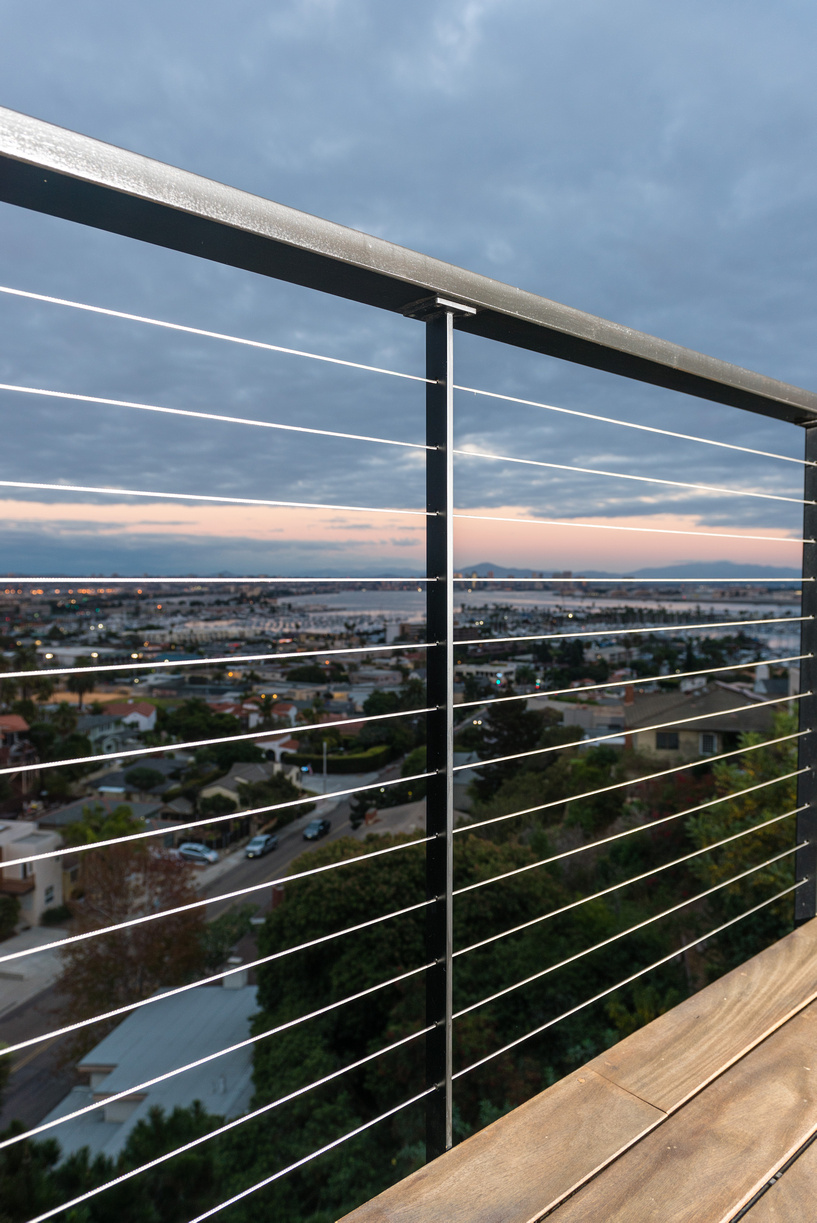
Selecting the Best Materials and Finishes For Extreme Durability There are several terms used in the steel fabrication industry to describe corrosion. We receive a few common questions from consumers about “oxidation”, “contamination” and the possibility or resistance our products will provide against “rust”. Maximizing corrosion resistance is about understanding the different terminologies and taking preventative measures to protect your investment. All metals have the potential to “oxidize”; while certain metals like t316 stainless steel provide a much greater resistance to all types of corrosion and oxidation. Surface Contamination- Probably one of the leading causes of staining and/or oxidation is surface contamination. Contamination is not rust. This term is used to describe the build up of some sort of debris on the surface of metal. Animals, trees, bushes and irrigation are some possible causes of surface contamination. Attempting to clean metal with the wrong chemicals, or using steel wool on stainless steel or aluminum can also cause contamination. Stains from these sources are often confused with corrosion or “rust” however this is not always the case. Any build up of contaminants on the surface of exterior metal can cause staining. Prevention- Maximizing corrosion resistance is about preparation. There are several good ways to prevent contamination and maximize the life of your exterior structures. Coatings are a great way to add longevity to stainless steel and aluminum railings, while providing a protective layer that cleans easily. Exterior grade paints, epoxies and powder coating are all good examples of coatings. Selecting marine grade stainless steel for your project is another excellent preventative measure. All of the cable assemblies and fittings we provide are made using T316 stainless steel. Cleaning and protecting- Cleaning is probably the easiest way to extend the life of exterior metal; just keep it clean. A periodic wipe down and the use of a surface protectant or light oil can work wonders. When needed; a soft scotch-brite (non metal) pad works great with stainless steel cleaner to remove stubborn stains. A light film of oil on the surface of the metal will prevent surface contaminants from sticking or pitting, and make future cleanings easier. Stainless steel cable railings can last 30-50 years even in the most extreme conditions. Periodic cleaning will preserve the beauty of the metal and protect your investment for the long haul.
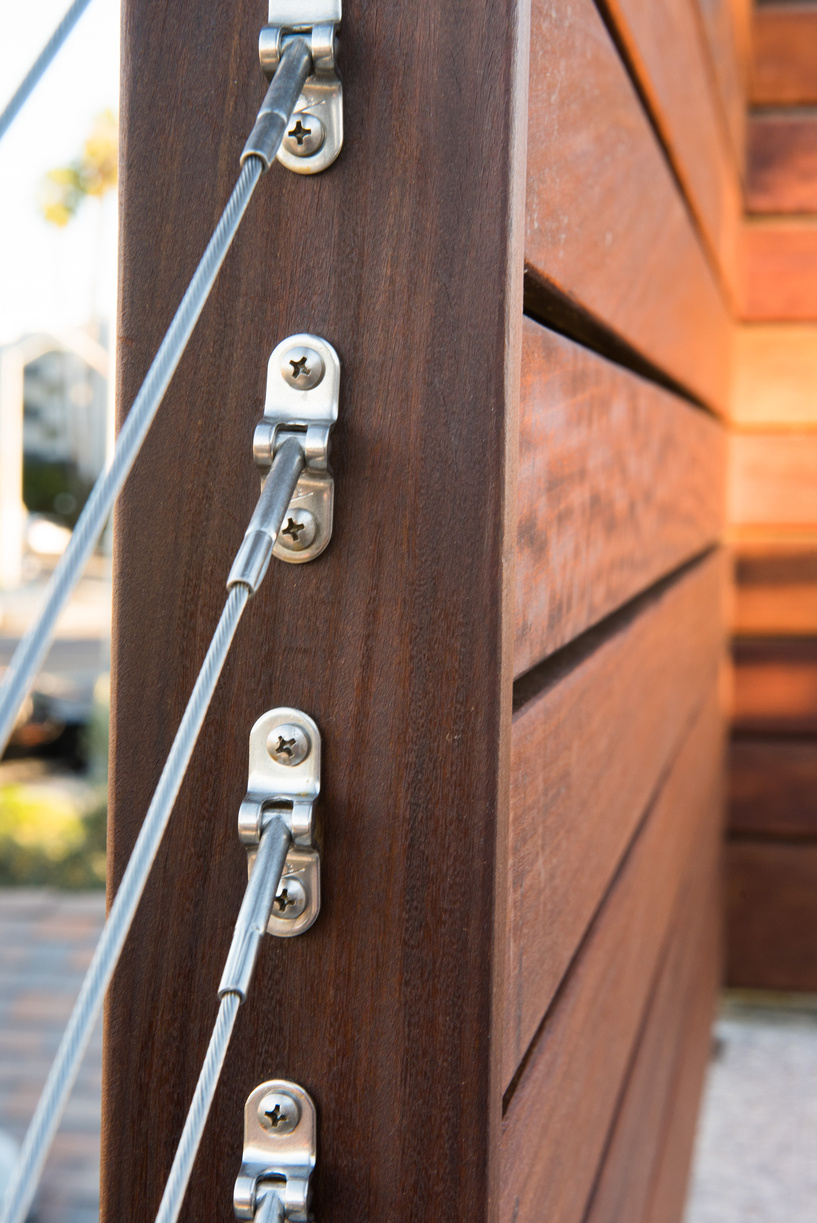
Selecting Wood Timbers for Your Cable Railings There is something special about using natural building products. Choosing wood for a decking project guarantees a unique end result; no two timbers are alike. The variety of colors and grain patterns are endless and the finish options are constantly improving. Here are a few good reasons to consider why wood framed cable railings may be the best choice for your next decking project. Wood Can Be a Cost Effective Way to Construct Decks, Fences and Railings Wood is a great value when it comes to exterior structures, especially decks. Wood is much less expensive than many composite decking products. Wood fences and railings will be much more forgiving than a product like vinyl. Synthetic products change over the years which can make a like for like repair difficult. Most wood timbers do not need to be special ordered or require any lead time to acquire. Wood framed cable railings will typically be less expensive than glass, composite or rod iron railings. Wood is an Ideal Choice for Customization Wood is an excellent choice for cable railings because it is available almost everywhere and it is very easy to use. Most homeowners have a selection of wood tools. Wood can be cut, sanded and fastened by novice carpenters much more easily than steel. When it comes to custom work like building railings, wood will hold it’s lines better than composite products which constantly swell and shrink. With a little imagination you can create a truly custom design by changing timber sizes and profiles. Wood Stays Cooler Wood does not generate or retain heat like composites (plastic) and steel. This is definitely a consideration for daytime deck usage. Lighter colored timbers will hold less heat and also weather well in hot or humid areas. Wood can be a great choice for top railing material, and can be combined with steel or synthetic post options. Natural Beauty With so many beautiful wood species available it’s hard to go wrong. Some of our favorite exterior wood types are Ipe’ and Cumaru which offer dark tones and tight grain patterns. For interior cable railing applications we like to use Oak and Mahogany. Oak is light in color and readily available. It can be stained almost any color to match existing floors or trim work. Mahogany is light brown to red and pink with tight grain patterns and excellent durability.
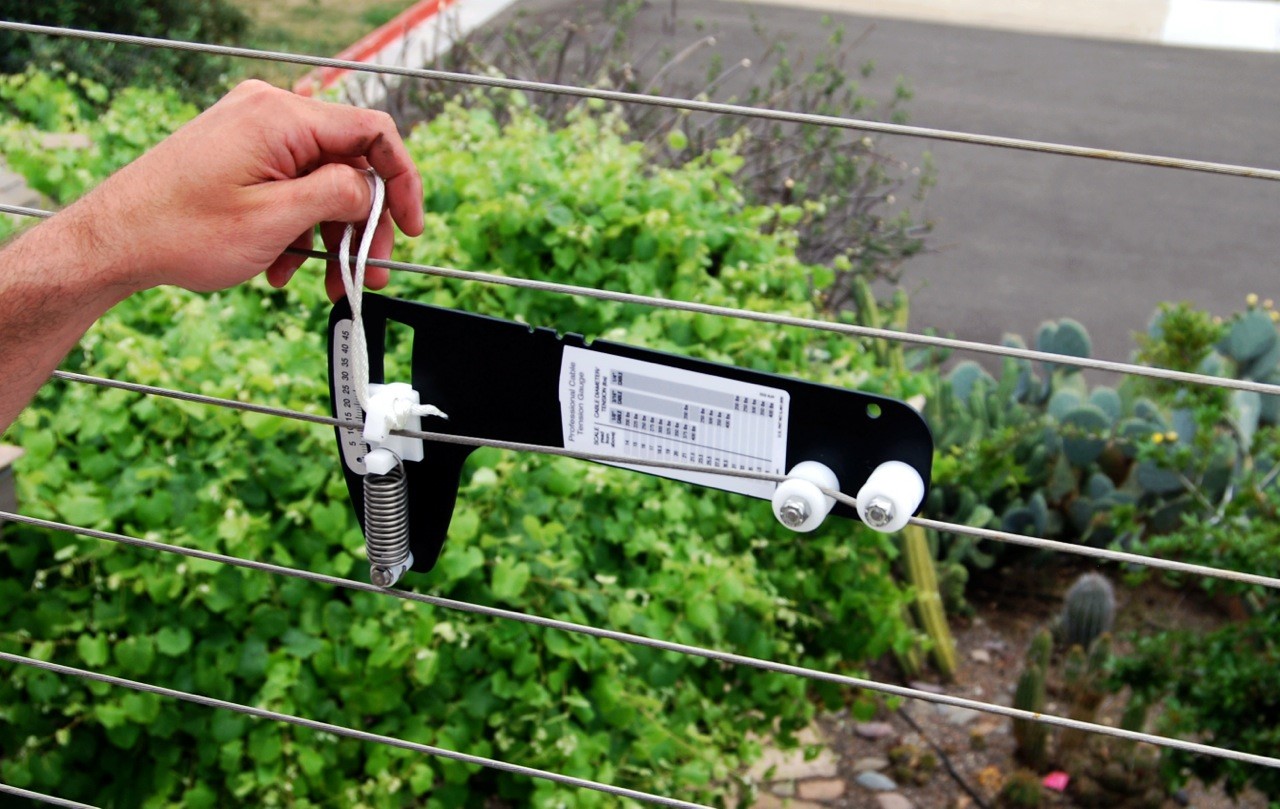
Cable Railing FAQ’S for Fast Estimates and Easy Installations In an effort to assist our customers with the most timely and cost effective cable railing estimates we’ve compiled a few of our most frequently asked questions: Q: Where is SDCR located? Is there a storefront? A: Our production facility is located at 4182 Sorrento Valley Blvd. San Diego, CA 92121. Our storefront is primarily online, however we do meet with some of our customers by appointment. If you would like to speak wth a sales associate about scheduling an appointment, please visit the quote request page or call our office at 844-277-7327. Q: What is the lineal foot cost for cable railing systems? A: Lineal footage cost estimates can vary greatly depending on project sizing, material type/s and the scope of construction. Typically larger exterior projects carry a lower price point than smaller interior projects. Steel framed cable railing systems are usually more costly than project using wood framing members. The quickest way to get an accurate lineal foot cost estimate is by providing photos and measurements to our sales staff. Q: How long does it take to get an estimate? A: Estimates for railing materials and installation are available within 24-48 hours upon receipt of a quote request form. Q: Does San Diego Cable Railings do installations? A: We have a network of cable railing installers serving several counties in California. Currently our network services San Diego, Orange County, Los Angeles, Santa Barbara, San Luis Obispo, San Fransisco and Sacramento metro areas. Our sales staff can provide accurate estimates for all of our cable railing product and installation costs. Q: Do Cable Railing Systems meet building code requirements? A: Yes! Cable Railings have gained popularity and recognition nationwide as a safe and durable option for residential and commercial guardrails. Our company offers engineering packages and connection details for plan submittals, and our installers have participated in building inspections statewide. As with any remodeling project it is important to check your local codes and standards prior to purchasing or installing any railing materials. Q: Does SDCR provide instructions or tech support? A: All of our railing packages include detailed instructions and our staff are available Mon.-Fri. for support calls and technical questions. For additional information and commonly asked questions please visit our FAQ page .
Choosing the Right Cable Rail Fittings for Your Project “Fittings”, “end hardware”, “tensioners” and “terminals” are all commonly used names for the stainless steel parts that terminate and tension cable runs. The quality and functionality of the fittings that are selected for each project will be an important safety factor. Additionally, properly selected cable rail fittings will ensure that re-tensioning or tune ups down the road will be simple and productive. Function vs. Flare- Years of field experience and feedback from contractors and installers have taught us a lot about cable hardware. When it comes to tension longevity or passing an inspection, we opt for functionality over flare. Trying to use the most concealed or low profile fittings may not always serve the project at hand. It’s important to remember that the individual technical factors of each job should dictate the fitting selection; not just the aesthetic considerations. Low profile and hidden fittings are sleek and attractive, however at times they offer little room for adjustment. On several occasions our preferred installers have been called out to inspect and repair cable railings that are “slacked” or “loose”. Typically the fittings or assemblies have been purchased on “eBay” or some other retail or online outfits that just sell the products. The cables have malfunctioned because the fittings selected did not provide enough tension capability. Upon installation they may have seemed tight; yet over time or due to acclimation they became loose, and provided no room for future adjustment. Many times these cables must be cut and new fittings must be purchased and installed. At SDCR all of our DIY cable assemblies are designed with strength and longevity in mind. We are happy to recommend cabling and hardware specifically catered to the job. Swaging vs. Crimping vs. Self Locking Fittings- Swaging is the process of joining pieces of metal together. A “machine swage” is usually done by the manufacturer via a hydraulic press. A machine swaged fitting to cable connection functions like a cold weld and is the strongest way to join cable and fittings. Most often, one end of the cable assembly receives a machine swaged fitting. The other end will be completed in the field by hand crimping or utilization of a self locking fitting which allows the installer to cut and install at exact length. Hand Crimped Fittings are installed in the field using a crimping tool which compresses the fitting on to the cable. Hand crimped cable rail fittings are the least expensive option; however crimping only provides about 70% of the strength of an actual swage. Crimping has been a cable rigging practice for decades and proven cost effective and durable. An approved cable crimping tool should always be used for architectural railing installations. Most recently Self Locking Fittings have become popular due to the ease of installation, with no need for crimping or swaging tools. Users can cut their cables and insert them directly into the fittings in one direction, while pulling in the other direction causes the fitting to grab tighter and tighter as tension is applied. Self Locking Fittings carry a premium for the convenience with the highest price point; however for DIY installers it can be well worth the cost. Another added benefit for the DIYer is the ability to release the self locking fitting if necessary. At San Diego Cable Railings we offer a large selection of cable rail fittings. Treating each project individually and assessing unique job factors, our pros can help you select the right hardware for the job. If you have questions about any of our DIY cable assemblies or stainless steel hardware; give us a call at 844-277-7327 (SDCR) or visit the quote request page.
CABLE RAIL CLEANING TIPS TO KEEP YOUR RAILINGS LOOKING NEW FOR DECADES A little bit of cleaner goes a long way.. Summertime is deck season nationwide and our exterior decks and railings are subjected to a multitude of harsh elements and UV rays. Here are some tips to keep all of the components of your railing system in top condition with little effort or expense. Fresh Water can be great for cleaning decks and railings if it is used sparingly and as long as all the components are allowed to dry. Keeping your railings clean will allow for the addition of penetrating wood oil finishes without the need for stripping or sanding. Fresh water can help to remove environmental contaminants, salt crystals, dirt and buildup. A light duty pressure washer is a perfect tool for easy cleaning and can be purchased for less than 100$. Pressure washers reduce the amount of water use while providing a powerful cleaning mist. Pressure Wash wooden or steel top rails, posts and cables on a low to medium setting. This should be done prior to using any cleaners or sealers. Allow all of the railing components to dry out thoroughly before cleaning or sealing. Mild sunny days are the preferred weather conditions. Stainless steel posts and cables can also be cleaned with a scotch brite pad and soapy water then rinsed clean. It is NOT RECOMMENDED to use steel wool, or any metallic scouring pads on stainless steel cable railings. Stainless Steel Cleaner should be used as a final step to achieve a clean protective finish on railing frames and stainless cables. Lightweight oils in the cleaner can prevent airborne contaminants from pitting into posts and cables as well as repelling moisture and salt buildup. It’s very important to utilize only cleaning products designed for high quality stainless steel. Testing a small spot of cleaner in a non visible area is always a good idea on coated finishes. Penetrating Oils are amazing products for wood preservation. If your wood top railings are clean and dry it’s time to add the oil. A good test is to use an eye dropper to wet a small spot on the top railing. If it beads up then the finish is still heavy but if it soaks in then it could be time for another coat. Hardwoods like Ipe’ are difficult to penetrate for the first couple of years and require a couple of coats a year until the finish really soaks in. If you have questions about cable rail cleaning products or techniques used for our railing systems, give us a call at 844-277-7327 or visit the quote request page to submit your question.
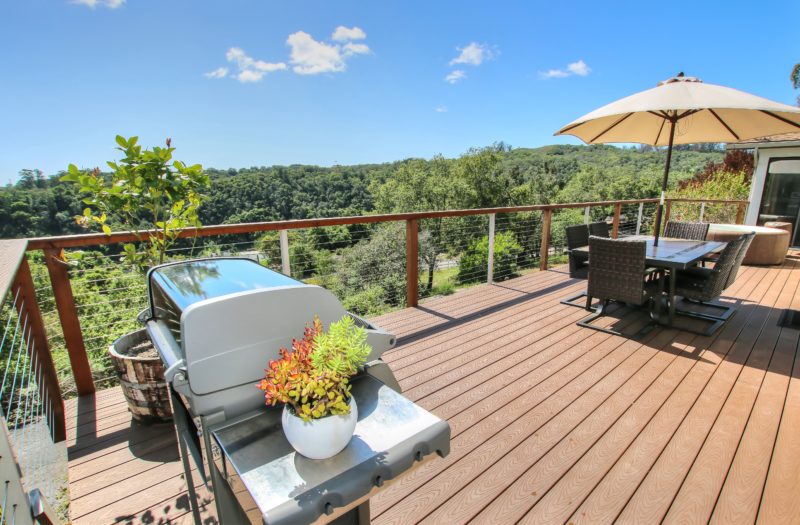
Did you know that you can build your own cable railing? We have DIY customers in all 50 states that have utilized our product line in order to assemble cable railings and fences. Our experienced staff and user friendly cable railing systems will provide everything you need to build your own cable railing. Our project photograph in this article showcases a beautiful deck railing that combines wooden posts with intermediate picket posts. Generally, wooden railings and fences are a bit easier to build for the average do it yourselfer. Picket posts are also lightweight and easy to install. By combining wooden posts with steel pickets you can expand the viewing windows from your deck. Additionally, the lineal foot cost for a hybrid (wood/steel) railing will be lower than a complete steel or stainless steel railing. The customer that provided this photo lives in a rural setting and did not want an “ultra modern” or “contemporary” look that would stand out from the surrounding landscape. Western red cedar posts were selected for a natural look and were combined with SDCR intermediate picket posts . The intermediate picket posts were powder coated a light grey to match the house. Pickets offer a lean 1″ profile to contrast with the bulkier 3.5″ wooden posts. The neutral toned railing posts and 1/8″ stainless cable used on this railing provide a transparent framework to preserve the beautiful view. Product selection and preparation are important facets of any home remodeling project. Building your own cable railing can be fun and also provide cost savings when compared to hiring a professional. It is important to do your homework and utilize online resources and building code information prior to installing any cable railings. If you have questions about our products or need assistance with a DIY cable railing project, please use our quote request page or give us a call at 844-277-7327.
Cable railing reviews from websites like houzz.com and Yelp are an excellent way for potential customers to review product and customer service standards provided by San Diego Cable Railings. Houzz.com is a home remodeling platform that showcases images and construction companies dedicated to residential remodeling and home improvement. Customer reviews are a great way for potential customers to read about actual customer experiences which answer many common questions in detail and showcase the high quality railing products and customer service standards supplied by our staff. Our featured image for this weeks blog is a stellar review from an east coast cable railing customer. She was thrilled with both her experience and products. We prepared a job specific cable railing package containing all necessary stainless cables, fittings, cable railing posts, and hardware; shipped to the state of Maryland in less than 3 weeks! Our turn around times for cable railing packages are some of the fastest in the industry. Even custom cable railing packages can be prepared and delivered in 2-4 weeks. Some of our most popular railing packages include cable deck railings, interior cable railings, and cable fences. San Diego Cable Railings has received service awards from Houzz.com year after year and provided countless homeowners just like Mary with cable railing parts and accessories. We encourage our potential customers to do their homework and to explore the various platforms offering cable railing reviews and product descriptions. Home improvement projects are a large investment that should be enjoyable and produce outstanding results. Our sales and production staff go to great lengths in order to provide only the highest level of customer service and product quality. If you would like to view more cable railing reviews please click on the Houzz icon or visit our testimonials page to read about actual customer experiences with our products and services.
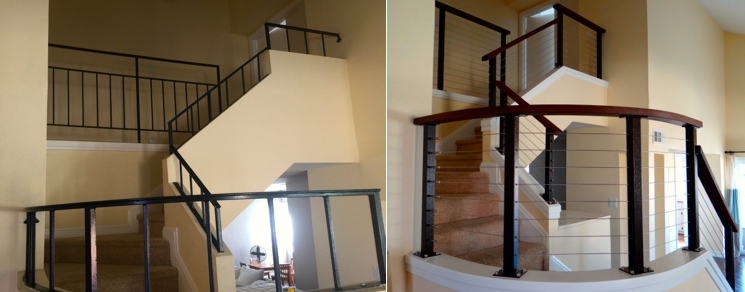
Modern Railing Solutions by San Diego Cable Railings remove years from the appearance of an older home. The featured image highlights a before and after progression performed by our preferred installers on a 30 year old stairway and bannister wall. The original railing (photo left) is a typical vertical picket iron railing. Iron picket railings were frequently utilized during track home construction for a quick and inexpensive railing solution. Today these railings do not always meet current building codes or safety standards. Notice the wide spread in between the vertical members. Additionally, these railings are frequently not tall enough, and will not sustain lateral loading requirements for residential railing systems. The aesthetics of the iron system provide little interest in comparison to the cable railing system and give way to the dated appearance of the entry. The components of the updated cable railing (photo right) feature a steel post and stainless steel cable infill, hardwood top railings, and updated wooden wall caps and trim. The update creates a complete transformation of the space. The use of steel posts and stainless steel cable provide modern railing solutions, while the wooden handrail and wall caps maintain a warm feel that is more in line with an older home. The updated railing makes the space appear larger, and provides a considerably more attractive focal point than the previous railing. Our team at San Diego Cable Railings has worked with countless homeowners designers and contractors, to provide unique railing solutions for a nationwide customer base. We have a growing network of preferred installers assisting homeowners with modern railing solutions for interior and exterior fencing and railing projects. If you have questions about any of our railing products or need assistance with the online storefront, give us a call at 844-277-7327 or submit a quote request via the contact form.
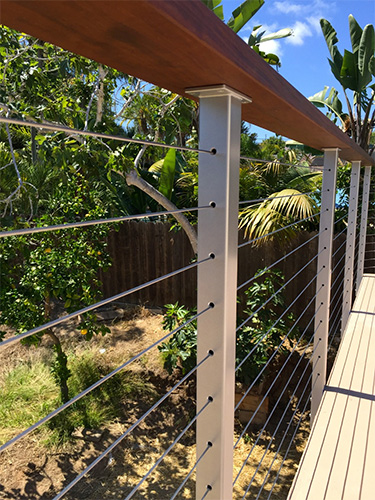
Cable railing systems cost can vary widely depending on individual job specifics. Lineal footage, material selection, and a variety of other factors can contribute to the cost of your cable railing systems. We receive numerous phone calls asking for ballpark lineal foot cost estimates which can vary greatly depending on the job. For budget preparation, the safest way to estimate a cable railing installation is to include as much detail (measurements, photos, stops, starts) as possible. Below is a brief summary of some common factors relating to “cable railing systems cost” : Framing Materials Wood framing is typically the least expensive way to construct a cable railing. Wooden posts and railings can be sourced easily and usually locally. For semi-skilled, or DIY installers, wood framing can be easier to work with and less painful to the pocket book if a mistake is made.